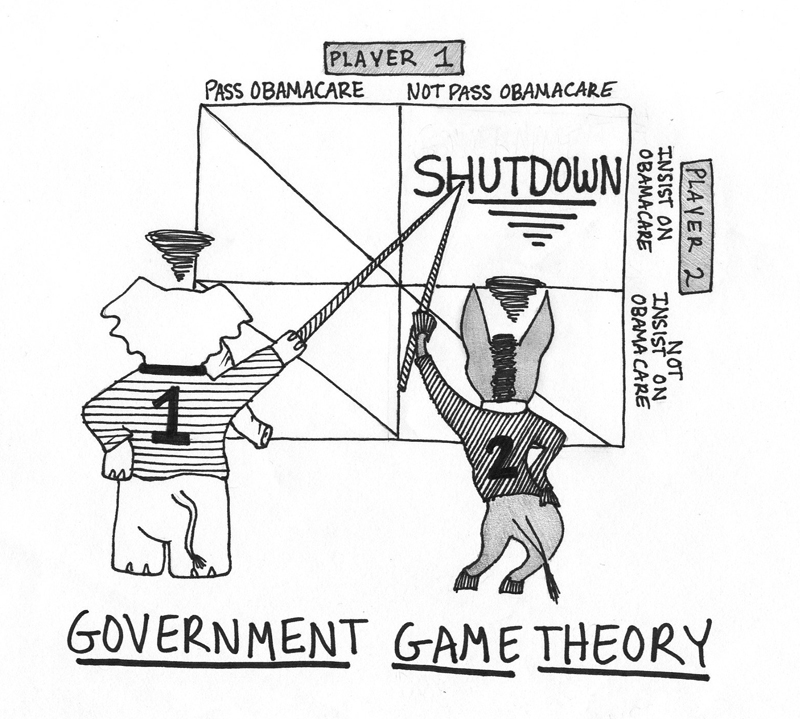The government’s shutdown this last month caused many Americans to ask, how did this happen? Many point to the Affordable Care Act (ACA). Others point to the Republican-controlled House of Representatives, and largely to the Tea Party, as being responsible for the House’s failure to open the government. The opportunity for blame is bountiful but, regardless of the blame, or what the political factions were, there is something we can learn from this experience.
The learning experience I am talking about isn’t one of the boring rants I am sure you heard. These include rants about how America is failing, how it was American democracy or anything else along those lines. What the American public saw play out during the government shutdown was a lesson in game theory and economics.
Game theory is the idea that people are self-interested and will act to achieve the best possible outcome, or attain the highest utility (happiness/pleasure) for themselves, while taking into account what others will do. This principle of economics and game theory is founded a concept called the “Nash equilibrium.” Those who have seen the movie “A Beautiful Mind” will recognize this equilibrium, but its results are not as peachy as the movie. The reason is because the movie explained the Nash equilibrium by incorrectly portraying it as an act of positive, mutual cooperation to achieve the best ends.
The real Nash equilibrium dictates that individuals will not cooperate or concede. Instead, the equilibrium is focused on how to achieve the best possible outcome with your best prediction of what others will do in their situation.
The government shutdown gives us insight into how the Nash equilibrium plays out in reality, as opposed to its theoretical application in movies. The “prisoner’s dilemma,” a well-known exercise in game theory, shows why people (in this case, political parties) will not cooperate even if it is in their best interest to do so. This is a far more accurate description of how the equilibrium works than how to make sure you and your friends all get dates, as is the case in “A Beautiful Mind.” The government shutdown was a result of the Republican Party and Democratic Party making the best possible choice they had with their best guess of how the other would respond to their choice.
The Republican Party believed that it could maximize its bargaining position and achieve its best outcome by refusing to pass a budget unless it repealed the ACA.
The rationale behind this is that the Democrats, specifically President Obama, would refuse to allow the government to shut down because of the damage it would do to the nation. The Republicans would gain even if they allowed for the ACA to pass, which they did, because it would increase their bargaining power on other issues and allow them to extract concessions they otherwise would not have gained. The Democratic Party sought to maximize its position against Republicans in the negotiations. The Democratic Party would gain very little and be perceived as weak by Republicans had they allowed for the ACA to be repealed. The continued existence of the law was also more important to the Democratic Party as a whole than the government shutting down for a short period of time.
Democrats believed that Republicans would ultimately fold and allow the budget to pass without the repeal of the ACA because of political pressures on them from the public, the same public that will decide many Republican’s fate in the upcoming 2014 midterm elections. The Democrats’ judgment on Republicans ultimately backing down and allowing the government to continue to function was correct.
The Republicans were also correct, as they were able to secure a bargaining chip (or a few) in the future. The Nash equilibrium accurately displays how the government shutdown was a result of individuals taking rational judgments for their own self-interest. For those who think America is failing or Democracy is failing, think again. The Nash equilibrium is the only explanation for the government shutdown and explanations contrary simply ignore reality.
Kentucky Morrow is a College freshman from Edina, Minn.
Illustration by Priyanka Pai
The Emory Wheel was founded in 1919 and is currently the only independent, student-run newspaper of Emory University. The Wheel publishes weekly on Wednesdays during the academic year, except during University holidays and scheduled publication intermissions.
The Wheel is financially and editorially independent from the University. All of its content is generated by the Wheel’s more than 100 student staff members and contributing writers, and its printing costs are covered by profits from self-generated advertising sales.






